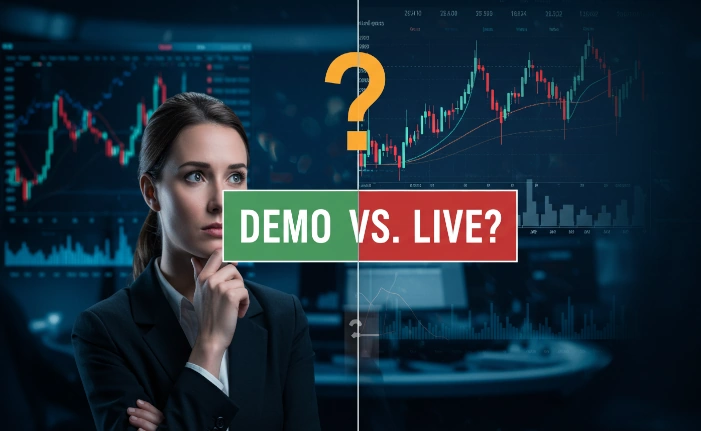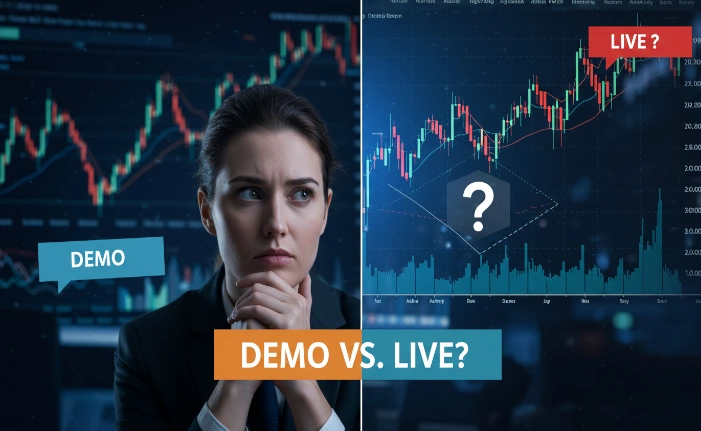The Demo Account Dilemma – Should You Use One Before Trading Live?
As a budding forex trader, you’ve likely stumbled upon the concept of demo accounts. These virtual playgrounds offer a chance to test the waters without risking real money.

Demo accounts, offered by most forex brokers, are simulated trading environments where you can trade with virtual currency. They allow you to test strategies, experience market fluctuations, and build confidence without risking real money. But are demo accounts a necessary steppingstone, or are they a crutch that hinders progress? Let’s explore both sides of the coin. Let me tackle the forex demo account dilemma, exploring its pros and cons, and helping you decide if it’s the right training ground for your forex journey.
What’s the Demo Account?
A forex demo account is essentially a simulated trading platform. Brokers offer these accounts with virtual currency, allowing you to experience the forex market without risking real money. Think of it as a flight simulator for aspiring pilots – you can practice takeoffs, landings, and navigating different weather conditions (market movements) without risking a real plane.
Advantages of the Demo Account
So, why consider a demo account? Here are some compelling reasons:
- Learning the ropes: The demo environment allows you to familiarize yourself with the trading platform, explore features like order types, charts, and technical indicators. This hands-on experience builds confidence before venturing into the live market.
- Testing your strategies: Developing a trading strategy is crucial. A demo account lets you test your strategy in real-time market conditions, allowing you to refine your approach and identify potential weaknesses before risking real capital.
- Developing discipline: Forex trading requires discipline – sticking to your plan and managing emotions. The demo environment provides a safe space to practice these skills without the pressure of real losses.
- Managing risk: Risk management is paramount in forex trading. Demo accounts allow you to experiment with different risk management techniques like stop-loss orders and position sizing, helping you develop a risk profile that aligns with your comfort level.
Limitations of the Demo Account

While demo accounts offer numerous benefits, it’s important to be aware of their limitations:
- Psychological disconnect: Trading with virtual money doesn’t replicate the emotional rollercoaster of real money on the line. Fear of loss, greed, and the thrill of a winning trade are absent, which can affect your decision-making in the live market.
- Limited execution experience: Slippage (the difference between the requested price and the actual execution price) doesn’t typically occur in demo accounts. This can lead to unrealistic expectations when transitioning to live trading.
- No real-time news impact: Major news events can significantly impact market movements. Demo accounts might not always reflect the dynamic nature of these events, potentially hindering your ability to react appropriately in the live market.
Demo Account Pitfalls to Avoid
While demo accounts are valuable tools, some pitfalls can hinder your learning experience. Here’s how to avoid them:
- Overreliance on demo accounts: Don’t get stuck in demo purgatory. While demo accounts are great for practice, eventually, you need to transition to live trading to experience the full spectrum of forex.
- Chasing unrealistic profits: Demo accounts often have a large virtual balance, leading some to chase unrealistic returns. Focus on developing a consistent, profitable strategy instead of aiming for overnight riches.
- Ignoring risk management: Just because it’s a demo account doesn’t mean risk management is irrelevant. Practice setting stop-loss and take-profit orders to build this crucial habit.
- Neglecting fundamental analysis: While technical indicators are valuable, demo accounts can lead to over-reliance on them. Don’t neglect fundamental analysis, which considers economic factors that drive currency prices.
- Treating demo accounts as a game: Demo accounts shouldn’t be seen as a game. Approach them with a serious learning mindset, taking notes and analyzing your trades.
By avoiding these pitfalls, you can maximize the learning potential of demo accounts.
Deciding Your Path: Demo or Live?

The decision to use a demo account depends on your individual learning style and risk tolerance. Here are some factors to consider:
- Trading experience: New traders can significantly benefit from the risk-free learning environment a demo account offers.
- Learning style: If you learn best by doing, a demo account allows you to experiment and gain practical experience.
- Risk tolerance: If you have a low risk tolerance, a demo account provides a safe space to test the waters before committing real capital.
Combining Demo with Live Trading
For some traders, the transition from demo to live can be daunting. Consider a hybrid approach:
- Micro-lots: Many brokers offer micro-lots, which are extremely small trading units. This allows you to test your strategies with real money, but with minimal risk.
- Start small: Begin with a small live account size, significantly lower than your demo account balance. This allows you to experience the emotional aspects of live trading while managing potential losses.
- Maintain demo practice: Continue using your demo account to refine your strategies and experiment with new techniques while trading live with micro-lots.
This hybrid approach offers a more gradual transition from the risk-free demo environment to the real world of forex trading.
How to Leverage Demo Accounts?
Instead of viewing demo accounts as a binary choice (use or don’t use), consider a more nuanced approach:
- Treat them as a training ground: Use demo accounts to hone your technical skills, understand fundamental analysis, and backtest trading strategies. This foundation will be invaluable when you transition to live trading.
- Simulate real-world conditions: Set realistic starting capital and trade sizes in your demo account to mimic the experience of live trading. This helps manage expectations and develop a disciplined approach to risk management.
- Set clear goals for your demo “training”: Don’t just trade aimlessly. Have specific goals in mind, like achieving a certain win rate or profitability level. This will give your demo trading a sense of purpose and help you track your progress.
When to Graduate to Live Trading?
There’s no one-size-fits-all answer to when to switch from a demo account to live trading. Here are some indicators that you might be ready:
- Developed a consistent trading strategy: You have a clear plan for entering and exiting trades, backed by technical analysis and risk management principles.
- Demonstrated consistent profitability on your demo account: You’ve achieved consistent profitability over a reasonable period (e.g., several months) on your demo account.
- Possess a strong understanding of market psychology: You acknowledge the emotional aspects of forex trading and can manage your emotions effectively.
Remember, profitability on a demo account doesn’t guarantee success in live trading. However, consistent profitability coupled with a solid understanding of the markets and risk management increases your chances of success
The Bottom Line
For me, demo accounts were more than just a “try before you buy” scenario. They were my launching pad into the world of forex trading. Sure, the lack of real-world emotions can be a drawback, but the ability to experiment without risking my hard-earned cash was invaluable.
I spent months in my demo account, religiously tracking my trades and analyzing my results. I blew up a few virtual accounts (hey, we all start somewhere!), but with each “loss,” I learned a valuable lesson. I tweaked my strategy, honed my risk management skills, and most importantly, gained the confidence to take the leap into live trading.
The transition wasn’t without its bumps. The initial fear of losing real money was definitely there. But the foundation I built in my demo account helped me weather those early storms. Now, after a year of live trading, I can confidently say that demo accounts were an essential part of my journey.
Here’s the data to back it up: My win rate in the demo environment was around 60%, which dipped slightly to 55% when I went live. But the key metric for me was profitability. In my demo account, I achieved consistent profitability of around 3% per month. In live trading, that number has grown to a steady 4% per month.
The point is demo accounts aren’t a crutch – they’re a training ground. Use them wisely, set realistic goals, and don’t be afraid to experiment. When you’re ready, make the jump to live trading with a measured approach, and remember, forex is a marathon, not a sprint. Keep learning, keep

